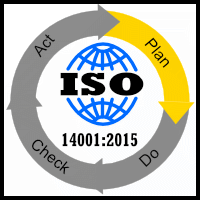FREE Quality, Health and Safety, and HR Business Software Click <HERE> to Learn More and Download
THIS SITE CONTAINS NO GOOGLE OR SIMILAR TYPE ADS and NO CLICK BAIT LINKS
QHSE Support >(Site Map) Environmental Guidance > ISO 14001-2015 Clauses > ISO 14001-2015 Clause 4 >
ISO 14001:2015 Clause 4.1 Understanding the organization and its context
|
PLAN |
DO |
CHECK |
ACT |
Clause 4.1 Breakdown
|
4.1 Understanding the organization and its context |
Context of the organization
Organizations can no longer manage their environmental management system as if they were a little pod on the side, a silo, detached to all that goes beyond the company gate, this approach is no longer acceptable. Organizations do not work in isolation and can be influenced by many and varied internal and external issues.
Organizations need to identify important internal and external issues relevant to the purpose of the business that can affect the stated outcome of the environmental management system.
Simplistic view... "Demonstrate an understanding of the organization's internal and external environmental issues, and characterize how they are managed within the environmental management system".
Examining the context of the organization further.
It consists of internal factors, external factors and environmental conditions. Organizations need to determine both internal and external issues that have an effect on the environment. This will include aspects of your organization within its control/ influence that go beyond your boundary fence. The key point here is understanding what organizational activities and processes it does within its boundary fence that has an impact off site.
Organizations need to understand:
External factors can include such things as society, politics, regulations, technological developments, cultural issues, the competition, economic changes.
Internal factors can include such things as the organizations processes, products or services, employees, contractors, culture (management and workforce), finances, existing and new contracts.
Environmental conditions to consider could be air/water quality, existing land, contaminated land, natural resources, biodiversity, climate. They need to be considered both on how they affect the purpose of the organization, and how they can be affected by its activities.
Within the standard, there are no specific documented requirements for clause 4.1. However, within the environmental management system as a whole, there will need to be evidence that the top management team considered the internal factors, external factors and environmental conditions. Indeed, these three elements are holistic throughout the environmental management system.
Samples of outside your boundary fence could be:
Near by river or water source: has the environmental management system identified?
•in what way can the organisation affect the water quality?
•does the organisation draw from or discharge to the water source?
•are emergency procedures in place to prevent accidental spillage contaminating the water?
•are emergency procedures in place if the water does become contaminated?
On the flip-side, what happens.
•if the river / lake bursts its banks?
•If the water source dries up?
•If the water freezes over?
•soil erosion and landslides?
It could be that the organization has a natural or man-made aquifer flowing under it's premises. The environmental management system will need to identify the aspects of the organisation's activities and processes that need to be examined to identify any impacts on the aquifer.
The organisation may be close to a railway line, or a chemical storage facility. Has the environmental system identified impacts such as derailments, chemical releases and explosions and have in place emergency response procedures?
Another example might be identifying issues that could affect the organisation's ability to raise capital to implement business improvements. What would be the effect on the business should key projects have to be cancelled.
It should be noted that it is unlikely that you are going to find these details in a nice neat 4.1 'context of the organization' statement. It is more likely that this information will be found in the management and management review meeting minutes, environmental policy, vision / mission statements, project plans, performance reviews, operational controls, work procedures, emergency response procedures, monitoring, measurement and performance figures, environmental objectives, environmental aspect and impact reviews etc...
Useful integrated management system cross references
ISO 9001-2015 4.1 - Understanding the organization and its context
ISO 45001-2018 4.1 - Understanding the organization and its context
Help file v1.175.0619 : Copyright © 2024 Brian G. Welch MSc(QHSE), NVQ4(OH&S), CMIOSH - Supported by Website On Safe Lines

